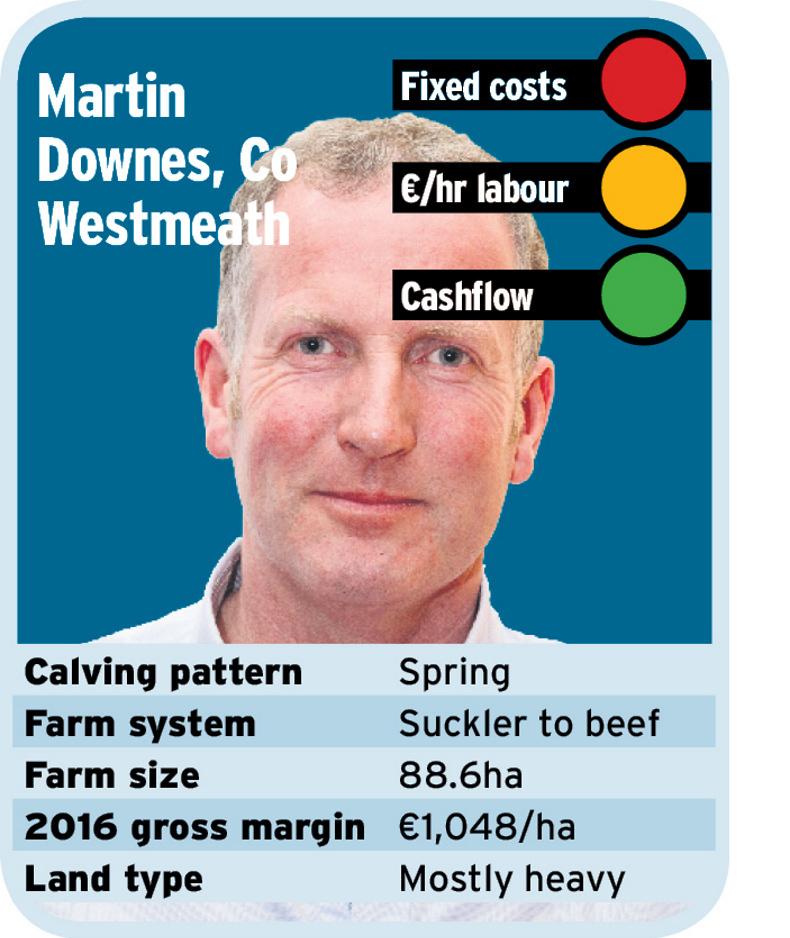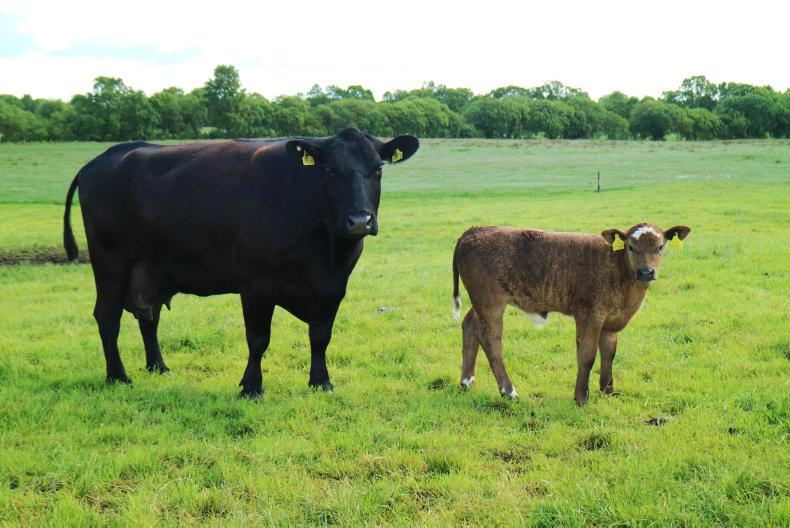Martin Downes’ farm comprises 89ha, split in two blocks, near the village of Multyfarnham, Co Westmeath. Though his 2016 e-profit monitor showed a healthy gross margin of €1,048/ha, this was achieved with a heavy reluctance. A significant number of TB reactors were removed from the farm last year, artificially ramping up his output levels. Some rented ground was also let go, concentrating his profits on fewer hectares. Indeed, his gross margin in the years prior to 2015 averaged around the €500/ha mark. As a result of the cull, he is back 20 cows for 2017 – beginning the year with around €26,000 worth of stock less on the farm than he did 2016.
To compound this, Martin’s cow herd is an old one – with an average age of over eight years. The challenge for him now is to build back up cow numbers to his desired level as well as culling out the inevitable trouble animals that will come with such a high-mileage herd.
Credit where credit is due – Martin has been proactive in freshening up his herd, with 11 heifers and an easy-calving Angus bull bought on to the farm. This year, 28 heifers in total have gone to the bull and Martin has picked out 16 cows for culling.

The herd
Martin’s plan for the suckler herd is to have 120 cows calving down in the spring. There is a flock of 160 ewes on the farm, which lamb in February and he plans to calve either side of these. He is aiming to calve 30 cows ahead of the flock and the remainder in 10 weeks from 1 March.
“I think keeping the early calvers will help to take the pressure off. In a bad spring it can be a nightmare if animals start to build up in the sheds. I have a small yard down the farm where I can put 30 cows and calves. They’ll go there while I’m lambing and can stay there as long as necessary.”
Martin was traditionally a bull finisher, with a brief cameo into bullocks in 2016. He is switching back to bull beef, keen to get animals off the farm earlier. Martin will select the best of his calves at weaning and run these through an under-16-month bull beef system.
“I hope to be able to get around 20 bulls away under 16 months. The team has advised me to be strict, with a minimum weaning weight of 350kg in bulls for this system. I suppose you’re aiming for the same endpoint and the lighter they are coming off the cow, the more meal it’ll take to get them there.”
The rest of Martin’s bulls will go back to grass in the spring for most of the season, returning indoors towards the end of August for finishing. The target will be to achieve around 1kg of daily weight gain at grass, coming into the shed around 550kg. They will receive meals for the final weeks at grass to acclimatise them to concentrates, before coming into the house for an 80-100 day intensive finish. Target slaughter weight will be 700-720kg.
In order to get more grass into his animals’ diets and push cheap weight gain, beef heifers will go to grass as yearlings for a full season, before coming into the shed for a second winter. The strongest will be pushed on to finish just before Christmas, while most will be stored on a silage-only diet (depending on forage quality) and return to grass for a third season as two-year-olds. Martin will be aiming to finish these older heifers at 27-29 months of age in mid-summer, when beef price typically hits its annual peak.
When carrying out projections for our BETTER farms, we are conservative regarding market prices and farm performance. Assuming that Martin is calving down 120 cows by the end of the programme and running at a mortality rate of 5%, he will have 114 live calves to work with. If 57 of these are bulls, there should be 20 meeting the criteria to push for under-16-month slaughter and 37 for the grazing bull system.
When Martin takes 25 replacements, there should be 32 beef heifers to go into his three-season heifer system. Based on carcase weights of 380kg for the underage bulls, 370kg for heifers, 380kg for cull cows and 410kg for the overage bulls and assuming base prices of €3.80 for underage bulls, €3.85 for heifers and flat prices of €3.90 and €3.30 for overage bulls and cull cows respectively, the farm should generate a gross margin of around €950/ha. This figure is based upon direct production costs coming in at 50% of output costs. This 50% target is where efficient beef producers should aspire to be.
While €950/ha is a healthy gross margin, both the team and Martin himself felt his is a farm that could do more. There is room for another system on the farm, but what to do?
“I didn’t want to go bringing in weanlings or stores to be honest. I have a bit of a problem with flightiness in my own herd and I don’t need the added hardship of excitable cattle coming in – while I get a man in a couple of days a week, this is largely a one-man show. Calves were mentioned but, to be honest, I haven’t the time to go rearing in the spring and won’t get the type of calf (beef-cross) that I’d want in the autumn … ”
Teagasc beef specialist Aidan Murray suggested a cull cow trading system at Martin’s planning meeting.
“You’ll aim to take in a store-type cow, or a forward one if there’s value, for no more than €1,000. You can start buying from October and aim to take in 25 between then and Christmas and a further 25 by early-February. You can feed them on good silage for the winter and push on any forward ones with beet to finish in the shed (Martin grows a small amount of fodder beet). The aim will be to turn the majority out and finish from grass in the summer time, pushing for a carcase weight in excess of 400kg,” Aidan advised.







 This is a subscriber-only article
This is a subscriber-only article

















SHARING OPTIONS: